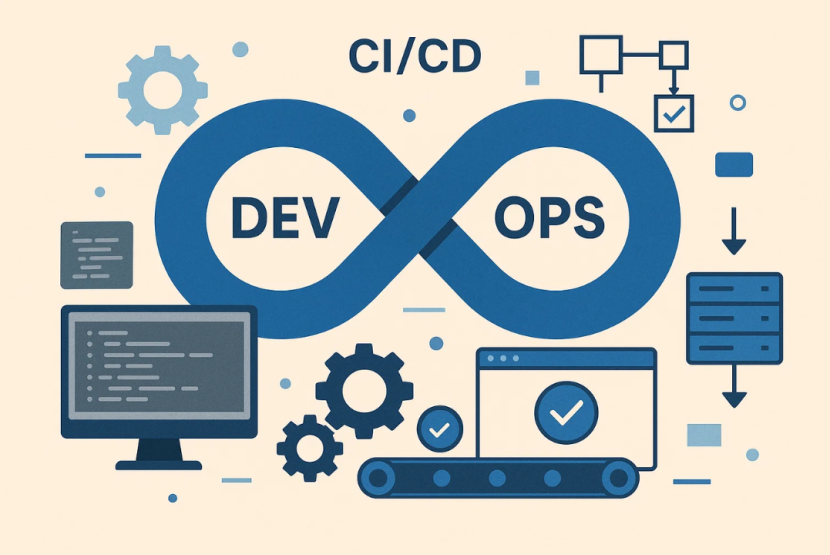In the rapidly evolving landscape of software development, delivering high-quality applications swiftly and efficiently is paramount. DevOps emerges as a transformative approach that bridges the gap between development and operations teams, fostering collaboration, automation, and continuous improvement.
Whether you’re a novice seeking to grasp the fundamentals or a professional aiming to refine your knowledge, this guide will walk you through the essentials of DevOps, CI/CD (Continuous Integration and Continuous Delivery/Deployment), and automation.
Understanding DevOps
DevOps is a cultural and technical movement that combines software development (Dev) and IT operations (Ops) to shorten the development lifecycle and deliver high-quality software continuously. It emphasizes collaboration, automation, and monitoring at all stages of software development.
Key Principles of DevOps:
The key principles of DevOps focus on fostering collaboration by breaking down silos between development and operations teams, implementing automation to streamline repetitive tasks and enhance efficiency, and embracing continuous integration and delivery to ensure that code changes are automatically tested and deployed. Additionally, continuous monitoring and feedback play a crucial role in assessing system performance and rapidly incorporating improvements for better outcomes.
The DevOps Lifecycle
The DevOps lifecycle is often depicted as an infinity loop, representing the continuous and iterative nature of the process. It encompasses the following phases:

- Plan: Define project objectives and requirements.
- Develop: Write and review code collaboratively.
- Build: Compile code and generate build artifacts.
- Test: Perform automated testing to ensure code quality.
- Release: Prepare the application for deployment.
- Deploy: Deploy the application to production environments.
- Operate: Manage and monitor the application in production.
- Monitor: Continuously monitor performance and gather user feedback.
For a detailed exploration of each phase, refer to GeeksforGeeks: DevOps Lifecycle.
CI/CD: The Backbone of DevOps
Continuous Integration (CI) and Continuous Delivery/Deployment (CD) are integral components of DevOps, enabling teams to deliver software more reliably and frequently.
Continuous Integration (CI):
CI involves automatically integrating code changes from multiple contributors into a shared repository several times a day. Automated builds and tests are run to detect issues early.
Benefits:
- Early detection of bugs.
- Reduced integration problems.
- Improved code quality.
Continuous Delivery (CD):
CD ensures that code changes are automatically prepared for a release to production. It involves rigorous automated testing to validate changes.
Benefits:
- Faster and more reliable releases.
- Reduced manual intervention.
- Enhanced customer satisfaction.
For an in-depth guide, visit Opkey: CI/CD Pipeline – The Beginner’s Guide.
The Role of Automation in DevOps
Automation is the cornerstone of DevOps, enabling rapid, consistent software delivery by streamlining key processes. It includes Infrastructure as Code (IaC), where infrastructure is managed through code using tools like Terraform and Ansible; Automated Testing, which ensures code changes are validated through continuous test execution; and Continuous Monitoring, which tracks application performance and health automatically to detect and address issues early.
Explore more about DevOps tools at Spacelift: 73 Most Useful Tools to Use in 2025.
Top DevOps Tools (2025 Edition)
Here’s a categorized list of popular tools:
| Category | Tools |
|---|---|
| Version Control | Git, GitHub, GitLab |
| CI/CD | Jenkins, CircleCI, Travis CI |
| Configuration Management | Ansible, Puppet, Chef |
| Containerization | Docker, Kubernetes |
| Monitoring & Logging | Prometheus, Grafana, ELK Stack |
| Collaboration | Slack, Microsoft Teams, Jira |
For a comprehensive list, refer to Atlassian: DevOps Tools.
Benefits of Implementing DevOps
Implementing DevOps brings a range of important benefits to organizations. It accelerates delivery, helping teams bring new features to market faster. Improved collaboration between development and operations teams fosters better communication and smoother workflows. Automation increases efficiency by reducing manual errors and eliminating repetitive tasks. Continuous testing practices enhance quality by catching issues early in the development cycle. Additionally, it allows for scalability, making it easier for teams to expand infrastructure and adapt quickly to changing business demands.
Challenges in Adopting DevOps
- Cultural Shift: Requires changes in organizational culture.
- Tool Integration: Selecting and integrating the right tools can be complex.
- Skill Gaps: Teams may need training to adopt new practices.
- Security Concerns: Ensuring security in automated pipelines is crucial.
Conclusion
Embracing DevOps, CI/CD, and automation transforms the software development process, leading to faster delivery, improved quality, and enhanced collaboration. While the journey requires commitment and adaptation, the benefits significantly outweigh the challenges.
For a practical walkthrough on setting up your first CI/CD pipeline, check out Dev.to: Getting Started with CI/CD.




